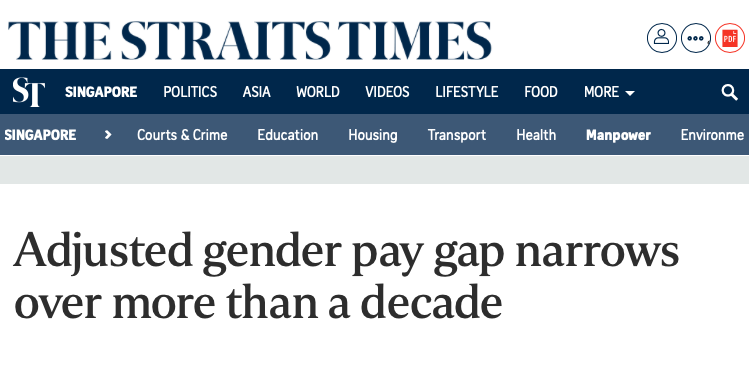This is known as the adjusted gender pay gap. Simply put, the adjusted gender pay gap compares the pay of a man and a woman if all other things are equal: same qualifications, same job, same rank. And it tells us that a woman will earn 6% less than a man in such a situation.
But I’m not here to discuss why this is so. Instead, I want to direct your attention to how the newspapers in Singapore covered this piece of news. This is TODAY’s headline:


So which is it? Is the gap becoming bigger (TODAY) or smaller (The Straits Times)? Is one of these articles going to be splashed with an ugly red FALSE?
The answer: neither will be POFMA-ed because both statements are true.
The reason behind this apparent contradiction is that TODAY based its comparison on the unadjusted gender pay gap. In 2002, the unadjusted gap in Singapore was 16%; it was 16.3% in 2019. 16% to 16.3%, that’s a simple increase.
On the other hand, The Straits Times used the adjusted gender pay gap as basis for its headline. The adjusted gap was 8.8% in 2002; it was 6% in 2018. Again, it’s a simple drop of 2.2% from 2002 to 2018.
I will not speculate, in this article, why TODAY chose to use one set of figures and The Straits Times another. (Though I will do so privately—more on that later.)
Working in a media company myself, I am acutely aware that there is no truly neutral piece of news. Everything published online—no, everything that is being communicated—is laden with intention and serves an agenda. If not that of Mammon, then for some political or personal gain. Even in the most ideal and Platonic case of communicating for the sake of educating, we must question: whose idea of ‘knowledge’ are we spreading?

A 300% jump in train breakdowns might mean, in real numbers, an increase from 1 breakdown per year to 4 breakdowns per year. That will ruin more people’s days and moods, yes. But when compared to saying, “there are now 4 breakdowns instead of 1 in a year”, the 300% figure disproportionately amplifies the emotional response to the piece of news.
Even though putting numbers in relative terms and setting the context help us absorb the piece of news and integrate it into our framework of the world more easily, the frame inevitably distorts. Play with the x- and y-axes of a graph and you can end up with an infinite number of shapes even if the data doesn’t change.
In these cases, what is best, perhaps, is to present the data on its own and let readers judge the import of the news, as CNA does here:

As illustrated above, the issue arises when an authority figure tells us how to interpret numbers, or what’s right and what’s wrong. In fact, when we are instructed to adopt a certain perspective, that’s when we should be more suspicious and scrutinise the information ourselves.
We should question, “Why is TODAY telling us the pay gap is ‘growing’ while The Straits Times asserting the pay gap is ‘narrow[ing]’? What is the point behind an authority figure telling us what to think?”
Only then can we firmly reject all attempts to drive a wedge between the facts out there and our understanding of the facts.
Let us not go down the path of other countries which are struggling with the politics of division.






